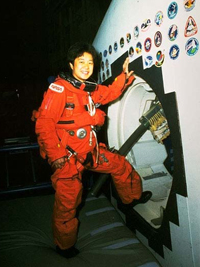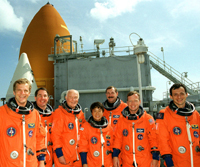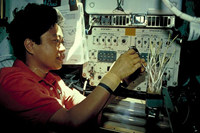 |
 |
|
  |
|
When was your first
flight into space? |
 |
|
 |
| Entering a mock-up of the shuttle in
an air-tight training suit (December 1993). |
|
I boarded the American Space Shuttle Columbia in
July 1994 as a payload specialist. I carried out 81 experiments in many
different fields. Almost two-thirds of them were experiments in the life
sciences.
One was on the effect of gravity on cell diffusion
in the egg of a Japanese newt until the birth of the baby newt. In another
experiment I observed the laying, fertilization, and hatching of eggs of
the killifish and was able to confirm that living organisms can give birth
to a new generation even in space. Compared to the process on earth, there
were some small differences in cell division, but I felt I had seen the
wonder of life.
Through these kinds of experiments in space, we can gain a better understanding
of life and the environment on the Earth. |
|

|
|
How was your second
flight? |
 |
|
 |
| The crew for the Discovery's1998
flight. |
|
John Glenn, the first American to circle the globe in
1962, was one of our crew members on the Discovery when we took off
in October 1998, and at 77 years of age, he became the oldest astronaut
in space. In our environment with very little gravity, young astronauts
had experienced phenomena closely resembling those of aging, such as sleeping
difficulties and degeneration of muscles and bones. Glenn's presence among
us was to facilitate research into this aging in space.
|
|
 |
| Conducting a plant experiment on Discovery. |
|
We analyzed Glenn's blood and muscles, and we used fish
called frogfish to investigate the mechanism of space sickness. We also
did experiments with plants, watching to see how corn and bean sprout roots,
which extend in the direction of gravitational pull on earth, would grow
in a weightless environment,and also observing changes in the protuberances
on cucumbers, which have an important role in germination. These were very
important experiments, since they not only produced valuable data on the
way plants grow but also suggested the possibility in the future of cultivating
plants to obtain food while traveling in space. |
|
|









